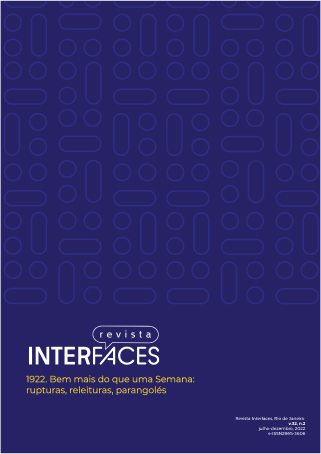A arquitetura neocolonial e a questão da identidade nacional: do apogeu nas exposições de 1922 à queda pelos modernistas fundadores do SPHAN em 1937
Neocolonial architecture and the question of national identity: from its heyday in the 1922 exhibitions to the fall of the modernist founders of SPHAN in 1937
DOI:
https://doi.org/10.60001/ricla.v32.n2.4Resumo
O ano de 1922 pode ser considerado significativo pela comemoração do Centenário da Independência, mas também pelo debate sobre as influências culturais europeias na produção artística brasileira e sobre questionamentos relacionados à elite burguesa e política conservadora da República Velha. Os movimentos artísticos desse período, apesar de aparentemente antagônicos, trazem em comum o questionamento em relação às referências europeias e têm como referencial a tradição cultural ligada ao passado colonial, abordados, de um lado com a vontade de se rebelar contra o conservadorismo acadêmico e político, e, do outro, com idealização de apresentar ao mundo uma arquitetura brasileira. São diversas as questões e contradições do movimento moderno que vão se refletir na materialidade das cidades e na formação da “nova” identidade nacional de uma sociedade dita “civilizada”, um dos focos da política ditatorial de Getúlio Vargas no período do Estado Novo. O objetivo deste artigo é compreender e analisar nossa história e discutir as ideologias (e contradições) vinculadas às arquiteturas neocolonial e moderna, nas décadas de 1920 e 1930, e suas relações com a criação do SPHAN e a questão da identidade nacional, tema esse ainda atual, mas com a necessária ampliação e inclusão da diversidade cultural.
Palavras-chave: Exposições de 1922; Neocolonial; Moderno; Identidade.
Abstract
The year 1922 is considered significant due to the commemoration of the country's Independence Centenary, but also due to the debate on European cultural influences on artistic production in the country, and on questions related to the bourgeois elite and the conservative policy of the Old Republic. The artistic movements of this period — Modern and Neocolonial —, although apparently antagonistic, have in common the questioning of European references in artistic production in the country. They have as a reference the cultural tradition linked to the Brazilian colonial past, approached, however, in different forms: on the one hand, with the will to rebel against academic and political conservatism; and on the other, with the idea of presenting Brazilian architecture to the world, through the construction of buildings with national references. These issues will be reflected in the materiality of cities and in the formation of the 'new' national identity of a so-called 'civilized' society, one of the focuses of Getúlio Vargas' dictatorial policy during the Estado Novo period. The aim of this article is to understand and analyze our history and discuss the ideologies (and contradictions) linked to neocolonial and modern architecture in the 1920s and 1930s, and their relationships with the creation of SPHAN and the issue of national identity, a topic that is still current, but with the necessary expansion and inclusion of cultural diversity.
Keywords: Exhibitions of 1922; Neocolonial; Modern; Identity.
Downloads
Downloads
Publicado
Edição
Seção
Licença

Este trabalho está licenciado sob uma licença Creative Commons Attribution 4.0 International License. O envio dos trabalhos implica a cessão sem ônus dos direitos de publicação, inclusive em versão eletrônica online. Todos os diretos provenientes da venda da revista ficam cedidos à Revista InterFACES. A republicação dos trabalhos deve mencionar a publicação original em Revista InterFACES.


